Publiquem en format article la presentació oral que el Dr. Jordi Guimet va fer en el darrer congrés mundial de l’arquitectura, 24th World Congress of Architecture, que va celebrar-se a Tokyo (Japó), a final de setembre del 2011 (http://www.uia2011tokyo.com/en/). Aquest Congrés, que organitza la UIA (Unió Internacional dels Arquitectes), té lloc de manera itinerant cada dos anys, i reuneix prop de 10.000 assistents d’arreu del món, fonamentalment de l’àmbit de l’arquitectura.
A més de diverses sessions plenàries on participen com a invitats experts mundials en les diferents àrees temàtiques que són objecte de debat, i de sessions de presentació de comunicacions, se celebren tres sessions temàtiques sobre temes específics del moment, en les quals dos o tres experts invitats presenten i discuteixen els subtemes corresponents des d’una perspectiva global i de futur.
En la segona sessió temàtica, sota el títol “City after 2011”, es presentà i discutí sobre com la ciutat i el desenvolupament del territori havien de ser dissenyats a partir d’ara. Els panelistes van ser Hajime Yatsuka (arquitecte, Japó), Yu Liu (arquitecte, Xina) i Jordi Guimet.
Per l’interés del tema, que ens atany a tots i per la novetat del mateix reproduïm la versió original en anglès de la seva aportació, extreta de la presentació oral, de la qual fem un breu resum:
L’urbanisme tradicional sembla i pot canviar. Combinar la remodelació d’estructures físiques (urbanisme tradicional) amb una nova concepció del sistema ciutat, en el que la intel·ligència de les seves infraestructures (smart cities) i la intel·ligència col·lectiva i ciutadana tinguin un paper rellevant és la clau per aconseguir unes ciutats més adaptables, més usables, més “generades” pels seus usuaris i per tant més valorades i confortables. I on les persones que hi viuen en constitueixen l’ànima. I aquestes persones avui interactuen en xarxes virtuals, com abans ho fèien en els mercats, àgores o fòrums, amb la diferència que la quantitat d’informació que ara compartim i ens transferim, que ha estat sempre la base del nostre progrés, ara es multiplica per factors impressionants. La participació social com a procés vinculat a la nova intel·ligència col·lectiva és un fenomen imparable que cal tenir en compte des d’avui mateix. Les noves tecnologies Internet ens faciliten eines a través de les quals els components – ciutadans – de la gran xarxa social que és Internet poden aportar les seves opinions i suggeriments, de manera que els tècnics, autoritats i professionals responsables de la planificació aprofitin l’immens poder de la “intel·ligència col·lectiva” en que la Xarxa ha transformat la ciutadania, per tal d’aconseguir ciutats més flexibles, més adaptades als ciutadans, més sostenibles.
1. Current context. The challenges, the concerns
All we are aware of the big changes which are currently influencing our lives. A bunch of things are being rethought. Also the architecture, the urban design and the management of the cities has to be reconsidered under the new trends and challenges. Climatic change, energy sustainability, overwhelming population, natural disasters, among others, are at the present our principal concerns. Under these changing conditions it would be risky to try to draw a picture about the future. But I can talk about the tools which are at our disposition to assure a sustainable and safer future.
2. Technology in urban planning. Enabling technologies for the social participation
I will talk to you about technologies which we currently need and which are being included in the city design processes, in its management and in the management of disasters. But principally I will put in the spotlight the new and global phenomena of social participation, and how this social capital or collective intelligence is growing and is influencing Urbanism rather than city management.
In fact my presentation is fundamentally oriented to explain how the citizens participation, powered by new participative technologies, can contribute to deal with and to solve some of the problems we are facing.
3. Trends and technologies in the future city design
I could mention a few trends in thinking about the future cities. Problems do not have simple answers, unique solutions. But the need to intensify the use of technology, specifically the information technologies, is a common thread for all kind of solutions, because information is the raw material for our activities and decisions. That is true for urban planning as well.
The most important problems we have to deal with in planning and managing our cities are mobility, energy consumption and energy sustainability in the future urban reality, pollution and climate change. And I would like to include, in this context, the disasters, which are more and more frequent and with increasing impacts, in part due precisely to the climate change and the overpopulation of cities in many parts of our planet.
All these problems are interconnected, so the debate has to be complex, and in this debate we can find the ideas about the density of cities, how density represents less energy consumption, mobility is less necessary, so CO2 emission are lower, etc. You know that the city model determines the level of energy consumption of their inhabitants. So could we combine the benefits of dense cities with the life style of horizontal cities? Some experiences in this area are being undertaken in different parts of the world.
Another debate is about “fast cities” and “slow neighbourhoods”, also trying to combine a peaceful and comfortable style of life at home with the increasing need of communications and interconnections between cities and inside cities.
Recently and increasing use of the subsoil is being experimented in several big cities, since it is no land consumption, relatively cheap, and more efficient from the point of view of energy consumption than to build on new soil. In my country, to give an example, we are developing new juridical figures to promote these new uses of subsoil.
Also we are talking a lot about ecoarchitecture, green cities, natural materials and copying nature’s processes to take advantage of the natural resources in building and in the public services.
Smart cities is now a fashion, the idea of an intelligent and auto ruled city to guarantee a greater efficiency of the city systems thanks to an exhaustive control of many of its mechanisms and technological infrastructures and the on-line auto decisions of these infrastructures.
Now let’s talk about emergencies and city safety. In this field the use of IT is even more necessary. In the context of prevention and mitigation of consequences of disasters, Urban Planning has a very important role. Data and information is essential, so new technologies of Geographic Information Systems, Spatial Data Infrastructures, 3D models, simulations, augmented reality, etc., are useful tools to apply to the planner’s work.
I’ll present you an example in my country about how this information is available through the SDI for everybody, mainly for professionals developing urban plans, and which are essential to accomplish the building legal rules:
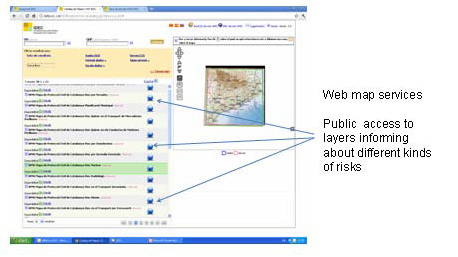 |
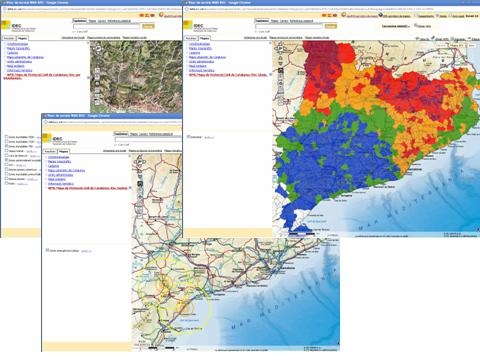 |
I do not want to extend my explanation in these aspects, because, as I said, this is not the focus of my presentation. It is only to affirm that in all these exposed trends, technology has an increasing role. Architecture is more and more involved in the use of technology, embedding it in the design process, bringing a human and beautiful format to the ugly technology.
4. Social participation in the urban design and management processes. The power of the networks
Now I will talk about the topic that has to be the focus of my presentation, the social participation on the city design and management processes in the current context. Participation itself is not a novelty, people participation has been more or less present everywhere, adopting different forms in different ways. What is new is the current “volume” and potential volume thanks to the new Internet participatory technologies that I will present. All of you are aware about the big change of Internet, now under the name of Web 2.0. This is the Internet universe that allows the interaction between users and the net: we book flight tickets, we answer surveys, we make comments on the web pages, we pay taxes, etc. Not to mention the “social networks”.
And why I am talking about that?
Let me present firstly a specific vision of what a city is about, a particular vision of the city concept:
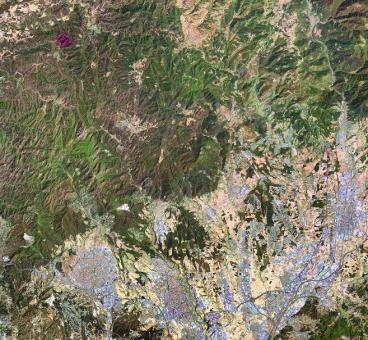 |
A piece of land, distributed by uses and functions, connected by a communications network, with rules of organization and an infrastructure on which finally we build our houses, factories and offices. |
|
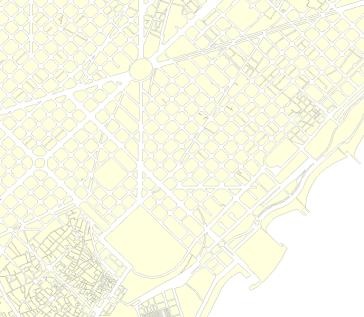 |
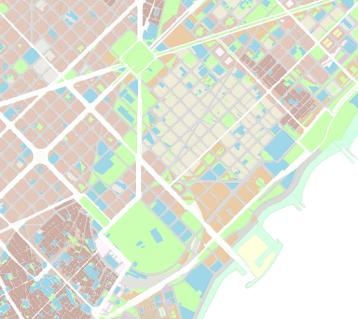 |
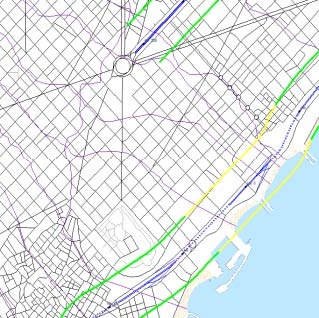 |
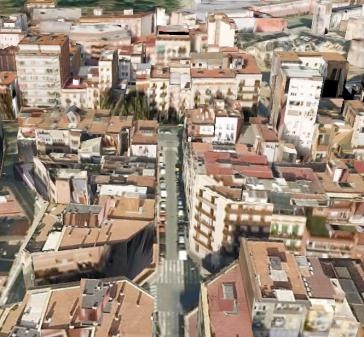 |
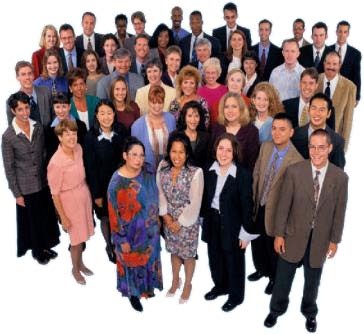 |
Finally, the citizens |
A piece of land, a street network connecting areas, infrastructures and furniture, buildings, and at the top, the citizens. And citizens are now, in a completely new paradigm, an immense network. All the elements of the city have remained more or less stable, except, and this is the greatest change, at the present, one of the components of the city, the citizens and their capabilities to interact, to participate, to build a collective intelligence of the city. And this represents a crucial change.
Before extending this idea, let me talk briefly about the hard and soft of the city
We know dozens of buzzwords: smart, intelligent, sustainable, digital, innovative…cities. All them are fundamentally related to the “Hard” of the cities, and do not consider many critical activities which are being done by the citizens, who are the “software” (the soul) of the cities. Participatory technologies are driving a most important role of this “software”.
Just as an aside, let me talk about some experiences capturing people’s reaction to the external world and mapping it in the city map, thus creating the Emotion Maps, like in Stockport, East Paris, San Francisco, Greenwich…
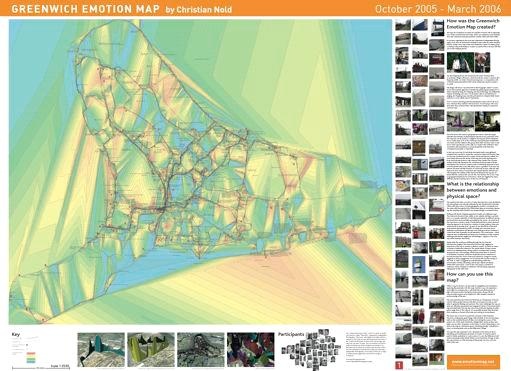 |
Also technology helps us collecting data about the movements of the citizens, observing their cellular devices localization over time. MIT SenseLab is working in this area. And we can extract interesting conclusions from the analysis of this information. And we have to include this new information into our usual, traditional methods of planning.
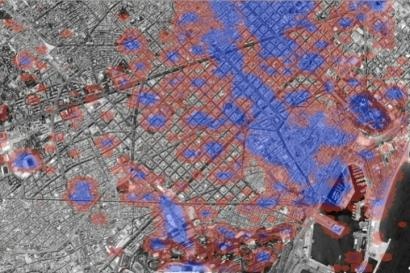 |
Tourist Density. The mapping of the georeferenced photos publicly available in Flickr reveal the density of tourists in downtown Barcelona in 2006. Source: Fabien Girardin, Universitat Pompeu Fabra |
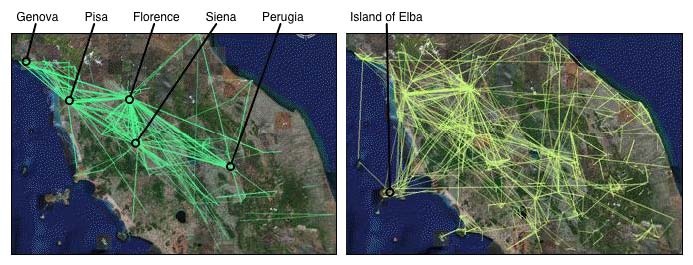 |
Traces left by Flickr users in and around the Tuscany region in Italy. Practically, a trace consists of a chronologically ordered set of geographically referenced photos taken by one person over the course of one day. Aggregating these personal traces reveal the travel behavior of specific types of visitors. For instance, the visualization on the left reveals that Americans follow a specific graph constituted by the nodes of Florence, Siena, Pisa, Genova and Perugia. On the other hand, Italians (right) are more adventurous in their exploration of the area (including reporting on visits of the Island of Elba). Source: Fabien Girardin, Universitat Pompeu Fabra. |
Let’s come back to the social active participation issue.
I want to mention specially the Neogeography, which is the map and geoinformation creation by end users, who are not experts, but are using similar tools and methods as those used in the professional field. Here some examples:
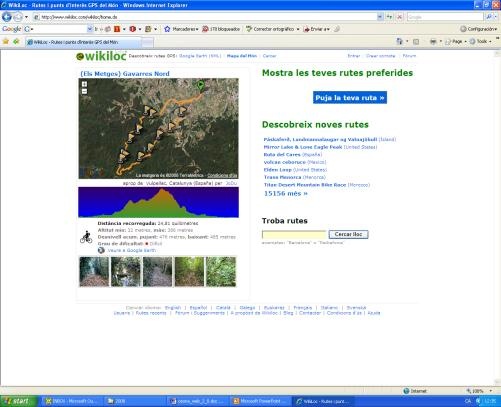 |
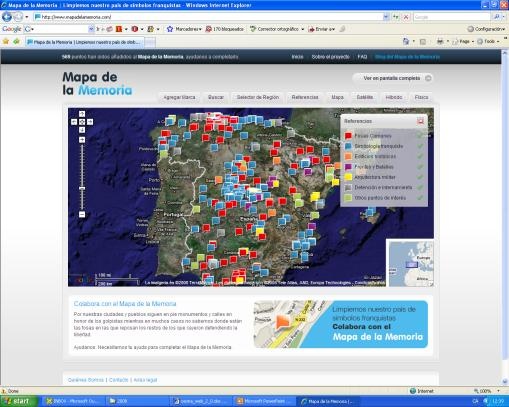 |
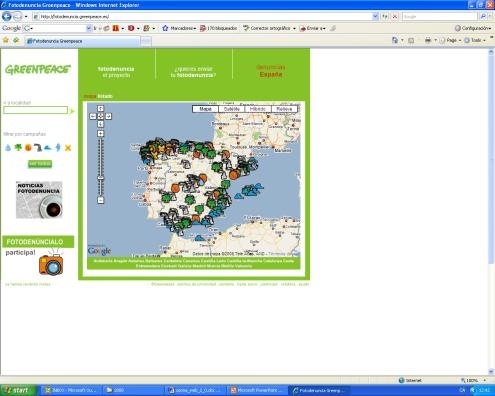 |
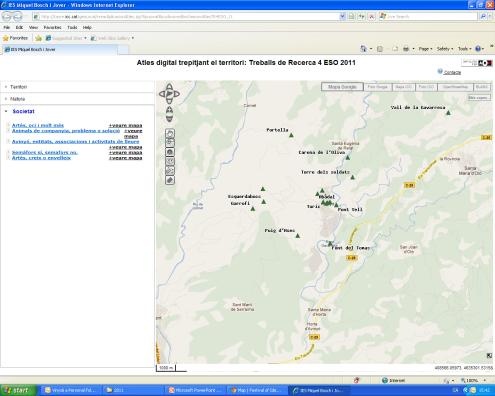 |
Every body can now create maps. All you need to do is to connect your Internet browser and to use any of the dozens of resources to do it.
This recent phenomena has a more generic concept, the crowdsourcing.
Crowdsourcing is a “distributed problem solving and production model”. Problems are broadcasted to an unknown group of solvers (citizens). The crowd submits solutions. It is part of the web2.0 applications. The public can be an excellent and active collaborator in many activities related with the normal and emergency situations. There have been a growing number of experiences with different web tools that make use of the crowdsourcing idea, in different fields of the urban management area: park design, neighbourhood services and transformation, etc.
New technologies of crowdsourcing make the “old” concept of public participation much easier, wider and more interesting. Probably it cannot replace the traditional way
to do things in many areas, but it allows to collect and manage much more information and to make better decisions. And remember that (city) planning is grounded in
information.
5. The role of the citizens in the urban planning
Let’s apply the former comments to our area of interest: the planning crowdsourcing.
As I said, public participation in urbanism is not new, what is changing is the way and the kind of participations, which can be done in different phases of the process. Having a look at Google under search words as “participatory urbanism”, you can find thousand and millions of references, what means that the phenomena is something already noticeable and increasing.
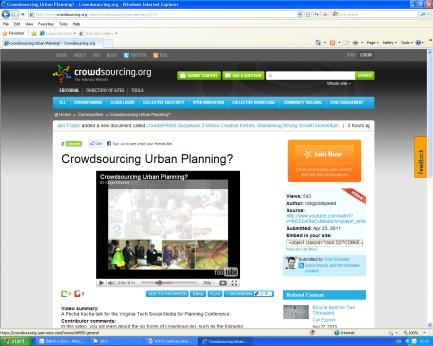 |
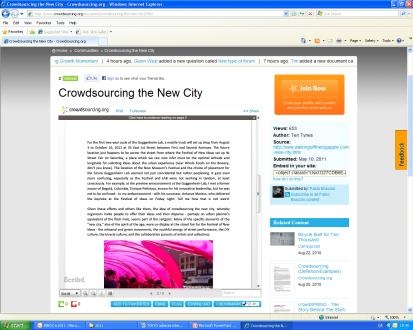 |
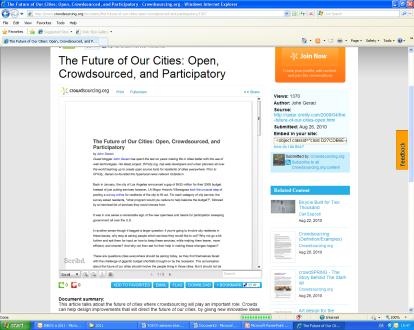 |
Activating the contribution of citizens, in city decisions, may foster transparency and a better connection to the public. But the experts authority does not disappear, because the information collected from the crowd has to be managed with technical skills.
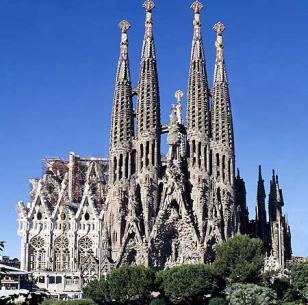 |
Who would have proposed such a kind of idea to build a new Cathedral? |
Essentially planning crowdsourcing can be seen as a process where citizens have a larger hand, than traditionally, in the designing process and in the implementation priorities as well. It is an intelligent gathering mechanism to better understand issues facing a community.
We notice that the emergence of “social production”, with clear economic and social impacts, is a new source of opportunities. It is a long term shift. Therefore it is necessary to take into account a new vision of how to cope with city problems and citizens’ expectations.
On large scales, where potentially thousands of people are involved, the results could be confusing, so it seems a more useful tool for limited areas with specific problems well- known by the citizens, as can happen in intermediate cities or in big city neighbourhoods.
6. The role of the citizens in the emergencies management
Citizens participation brings an important value in the management of disasters mitigation, so we have to take it into account.
In fact, rules and preventions can not be as effective as foreseen because of the chaotic overpopulation of wide zones of the world, which have converted open spaces in sealed building areas. So mitigation is a reliable point of view to cope with the consequences of the unforeseen.
Within some examples we also can refer to several experiences about public participation in emergencies:
The cases of New Orleans floods, Haiti earthquake, Ontario tornados… Are very recent examples of how we can take advantage of the volunteered activities of the citizens. It is recognised that data quickly updated by citizens is much more complete and precise than the official issued information.
On the other hand, there are no patterns in a disaster, conditions change with time and every time new information is needed to create and rethink new models and to take new decisions continuously.
In recent years, advancements in technologies have made it possible to provide increasing support to disaster preparedness and emergency response efforts. Post-disaster satellite imagery as well as the use of other space-based technologies such as telecommunications satellites and global navigation satellite systems provide new ways to manage the disasters. Virtual communities based on platforms such as OpenStreetMap, Ushahidi, Sahana, CrisisMappers, Virtual Disaster Viewer, etc., are mushrooming everywhere.
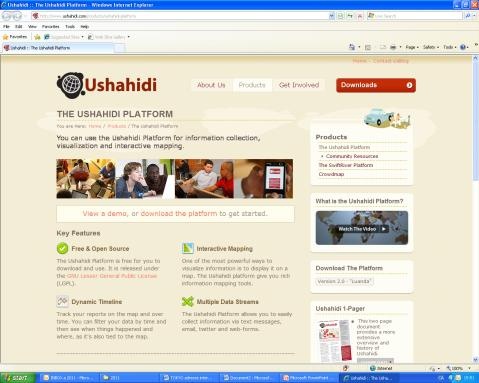 |
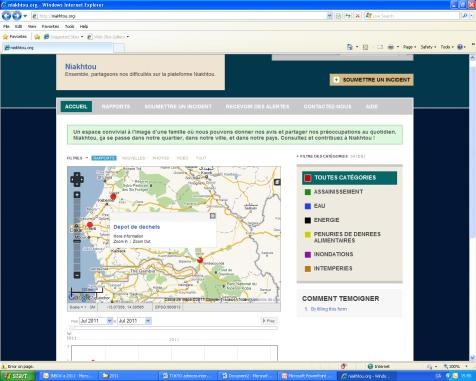 |
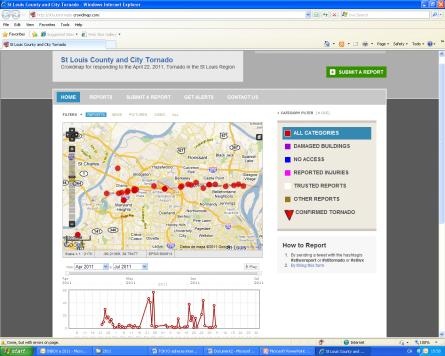 |
Platforms for citizen’s cooperation.
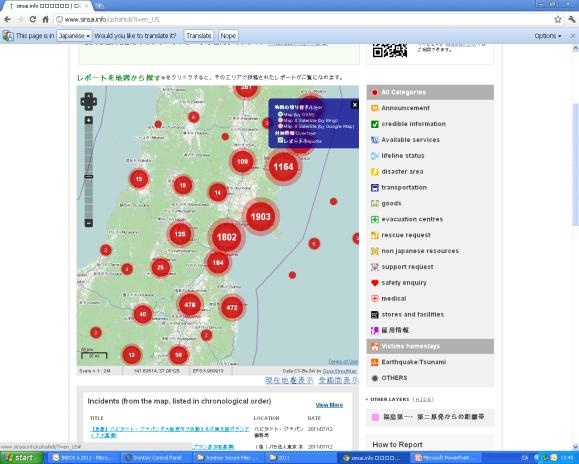 |
Incidents from Japan tsunami, |
The OpenGeospatial Consortium, a private non profit international consortium of more than 385 companies, government agencies, research organizations, and universities participating in a consensus process to develop publicly available geospatial standards, is working with the United Nations around the topic of crowdsourcing: “OGC Emergency & Disaster Management (EDM)”. United Nations is launching a specific program “Space-based information for Crowdsource Mapping Project” taking advantage from lessons learned from community involvement/support in Haiti.
Risks, disasters, have been here forever. But now they affect a growing population concentrated within 50 km of the coast. Not to mention atmospheric or radioactive hazards which are “global”, transbounder, and can be presents everywhere.
We are not able to avoid hazards, we are not able to avoid human settlements in risky zones…but we can try to minimize their effects. So it is important to improve the prevention, the preparation, the level of response and the disaster recovery, taking into account the social preparedness to undertake important roles during theses situations.
7. The power of the Social Digital Networks
Crowdsourcing, runs thanks to the Network. Let’s comment in depth the meaning of it.
All is a network: the unicellular organisms, the planet, the systems of cities, the cities themselves, our bodies (our heart system, our brain..), our interconnections with others… Networks explain many of the phenomena in biology. Geoffry Watts and his team from … `presented recently a scientific theory about the evolution of cities, applying the biological principles of scalability. In biology you can notice the importance of the concept of scalability. This scalability means that the bigger you are, the less energy consumption you need. Here is the example presented in this graph: size and energy consumption. The slope of the line is negative, that means than doubling the size (it is a logarithmic representation of the phenomena) the energy consumption does not increase in the same rate, only a 75%. A similar thing is occurring in cities. If you double its size, the number of petrol stations, to say an example, is multiplied by 0.75. On the other hand, organisms does not grow eternally, they stop, the collapse is part of the game. And you can find this rule anywhere in the biological world.
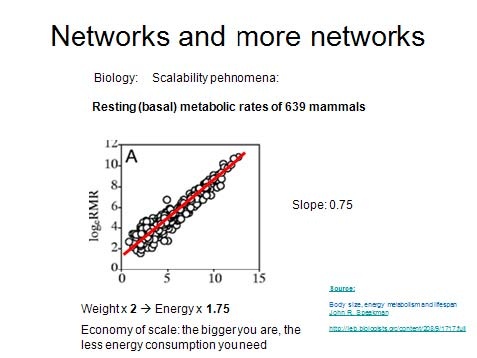
If we apply a similar analysis to cities, looking at socio-economic aspects, (for exemple wages, incomes..) the rule here is an exponent of 1.15-1.20, because the slope of the edge is positive, unlike biology. This means that if you double the size of the city, you will get a 15% increase in wages, wealth, flu diseases, crimes… Even the pace of live increases, life gets faster. And what is the reason for that? The social networks, a universal phenomena from the beginning of human beings. This 15% of increase rule is true no matter where you are in the planet, despite the fact that all cities have evolved independently. So, something which is universal is driving the phenomena. And what is universal is US. In fact, cities are spaces and scenarios for the interchange and sharing information, which has been the basis for the progress and evolution. Now we have new virtual spaces in which these interchanges can be multiplied by a factor of thousand, even millions, of times. We are the cities, people are the soul of cities. And people interact as networks. So we have on one hand an economy of scale in some aspects, and on the other hand we have greater opportunities (good and bad things) in the growing process. All this can be explained by the network theory.
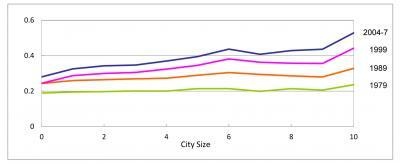
Cities scalability: wages and size
But I remind you that the systems tends to collapse. The growth stops. The resources run out. How can we avoid it? The key is innovation. The mankind has always managed with innovation to survive. There has been a continuous cycle of innovation, and as we grow and we approach the collapse, a major innovation takes place and we start all over again. The problem is that we have to innovate faster and faster. So we have to be able to maintain this effort to assure our future.
And at this moment, in this context, I am sure that the innovation has to be the use of social energy, social participation.
8. Conclusions
Summarizing, Social Participation is today and it will be tomorrow, a new global phenomena powered by new participatory technologies in the Internet Universe. Neogeography, Crodswourcing…, are new words for new social functionalities which have appeared thanks to the Net. And the social network till now has managed to innovate, as a basis to avoid the collapse. The key for the innovation we need to survive is precisely the Social Participation, the collective intelligence of our World.
Cities could be more people-friendly, more liveable, and safer when opening the process of planning, designing, changing, adapting and managing to a wider audience. Traditional urbanism seems to change. The old way (reshaping physical structures) is being combined with the redesigning of the system (the new way). This could change the whole playing field and therefore the way we are conducting the future. It is not a fashion, it is a deep change, it has to be a deep change. And this is the way to innovation, creativity, thus the way to avoid the collapse of the system.
The future will be invented collectively, with the contribution of all citizens. WE are the cities, solutions will come from the participation of our collective intelligence. The “citizen generated” city is becoming more and more usual in the current vision of the future city. This is my vision, this is how cities of the future will manage to define their future and maintain a safe and wealthy situation. Permanently adapted cities, combining the “smart hardware” of their infrastructures with the collective intelligence to drive into the next generation of cities of citizens.
References
http://www.geoportal-idec.cat.
http://stockport.emotionmap.net.
http://www.sf.biomapping.net/map.htm.
http://www.crowdsourcing.org.
http://www.ushahidi.com.
Body size, energy metabolism and lifespan John R. Speakman.
http://jeb.biologists.org/content/208/9/1717.full.
http://brainmuseum.org/evolution/paleo/index.html.
Understanding the City Size Wage Gap, Nathaniel Baum-Snow, Brown University & Ronni. Pavan, University of Rochester February, 2011.
http://www.restud.com/wp-content/uploads/2011/02/14277.pdf
The surprising math of cities and corporations, Geoffry West
http://www.ted.com/talks/geoffrey_west_the_surprising_math_of_cities_and_corporations.html
http://senseable.mit.edu/sos/



